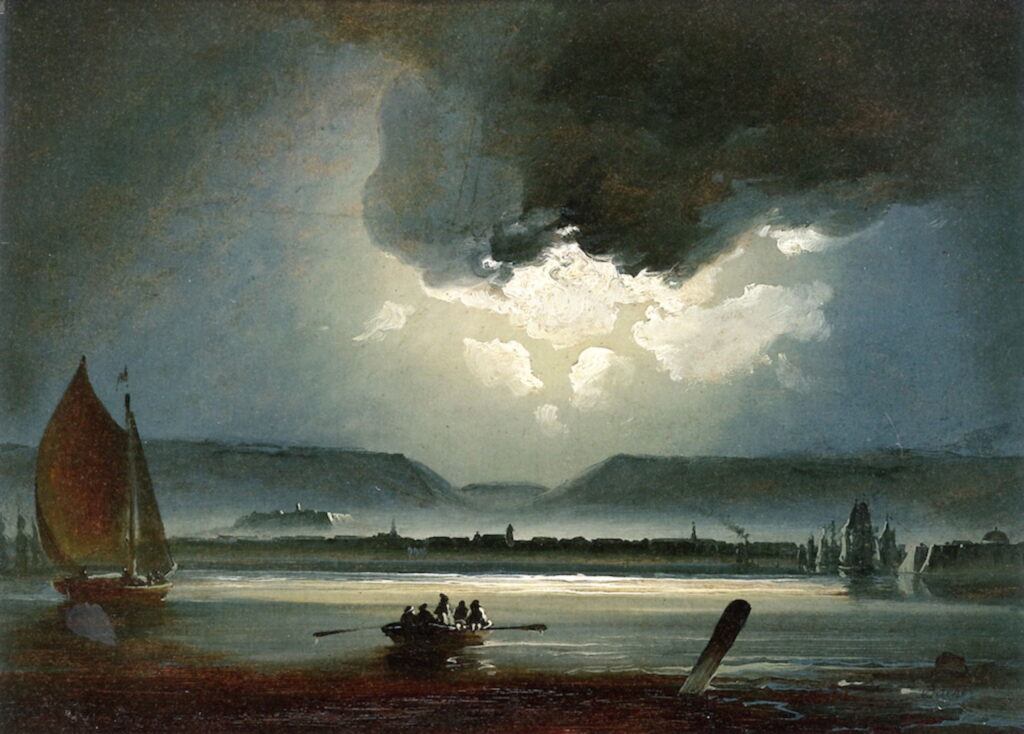Sea of Mists: Pupils, Peder Balke

During the nineteenth century painters from the Nordic countries gravitated towards what’s now Germany, and until 1815 part of the southern Baltic coast was Swedish. Caspar David Friedrich had been born and brought up there, in Swedish Pomerania, and his close friend and teaching colleague JC Dahl had been born in Bergen, Norway, when it was in union with Denmark. Both Friedrich and Dahl spent much of their careers in the city of Dresden, which became the centre of German Romantic painting.
While the Norwegian painter Peder Balke (1804–1887) isn’t normally considered to be one of the German Romantic painters, he was a pupil of JC Dahl in Dresden, and painted themes in common with the German Romantic artists. Originally his last name was Andersen, but in the 1820s he lived on the Balke farm, where local farmers supported his education in return for his decorating their farmhouses. He changed his name in about 1825, and two years later was working as an apprentice to the painter Heinrich August Grosch. Between 1829-1833 he trained at the art academy in Stockholm, Sweden.
When still a student in the summer of 1830, Balke walked through the mountains in Telemark to Bergen, then back to Hallingdal, a feat in itself, but he also made sketches that he later turned into paintings. In 1832, he toured Finnmark in much the same way, and it was this trip to the far north that inspired him to paint the remote coast of northern Norway, including North Cape itself.
Peder Balke (1804–1887), Mountain Range Trolltindene (c 1840), oil on canvas, 30.8 x 41.9 cm, Nordnorsk Kunstmuseum, Tromsø, Norway. Image by Illustratedjc, via Wikimedia Commons.
One of his earliest surviving paintings of the coast is this romantic and dramatic Mountain Range Trolltindene from about 1840. Its carefully framed clear patch in the clouds reveals this part of a mountain chain rising to over 2000 metres (over 6,500 feet), at the western edge of the great Rondane National Park in central Norway.
Peder Balke (1804–1887), The Harbor at Skjervøy (c 1844-46), oil on paper on cardboard, 12 x 17.5 cm, Private collection. The Athenaeum.
The Harbor at Skjervøy (c 1844-46) shows this small fishing port in Troms, in the far north of Norway. The weather is clearly blustery, and Balke’s sky full of wheeling seabirds.
Peder Balke (1804–1887), Ship in Breaking Waves (c 1840-49), oil on canvas, 64.5 x 91 cm, Bergen Kunstmuseum (KODE, the Art Museums of Bergen), Bergen, Norway. The Athenaeum.
From early in his career, Balke developed a liking for nocturnes, in which the moonlight could enhance the dramatic effect. Ship in Breaking Waves (c 1840-49) shows his skilful use of limited light and cloud, and the hazards to sailing vessels along these remote and rocky coasts. These may have originated in the paintings of Claude-Joseph Vernet in the previous century, influenced by JC Dahl’s series of nocturnes from the 1830s onwards.
The North Cape, at the far north of Norway, isn’t actually the most northerly point on the mainland of Europe, as it’s on an inshore island, and the adjacent cape of Knivskjellodden stretches slightly further north but has a less memorable name. Nevertheless, it’s an evocative location, and when Balke painted it, few had seen it, and despite being ‘discovered’ in 1553, it was considered more hostile and impenetrable than Cape Horn.
Peder Balke (1804–1887), North Cape (1845), oil on canvas, 95 x 132 cm, Nordnorsk Kunstmuseum, Tromsø, Norway. Wikimedia Commons.
During the 1840s, Balke started to paint a series of works showing the towering sea cliffs of North Cape. This version from 1845 seems to have been the basis for several later paintings, in which the motif became more elaborated.
Peder Balke (1804–1887), North Cape (c 1840-59), oil on canvas, dimensions not known, Private collection. Wikimedia Commons.
He painted several similar nocturnes of North Cape, this from some time in the 1840s or 1850s. These show calmer conditions, which contrast with the rectangular bulk of the cliffs, and a small boat being navigated across the reflection of the moon. During this period, he made similar versions for the French crown, now in storage in the Louvre.
Peder Balke (1804–1887), The Seven Sisters Mountain Range (c 1845-50), oil on panel, 25 x 31 cm, Private collection. The Athenaeum.
Balke’s painting of The Seven Sisters Mountain Range (c 1845-50) shows this spectacular chain of seven mountains on the northern section of the coast of Norway. They rise from sea level to almost 2000 metres (6,500 feet) in a tangled mass of rock spires and icefalls.
Peder Balke (1804–1887), Rough Sea with a Steamship Near the Norwegian Coast (c 1847-50), oil on paper, 33.5 × 42.5 cm, Statens Museum for Kunst (Den Kongelige Malerisamling), Copenhagen, Denmark. Wikimedia Commons.
This was the era of the first mechanically-propelled ships, as shown in Balke’s Rough Sea with a Steamship Near the Norwegian Coast from about 1847-50. The first steamship crossed the English Channel in 1822, and in 1839 the first driven by a screw propellor was commissioned. Balke’s painting must have been among the first to show such a vessel under way in remote parts.
Peder Balke (1804–1887), Moonlit View of Trondheim (c 1840-49), oil on canvas, 44 x 63 cm, Private collection. The Athenaeum.
Around 1850, Balke painted nocturnes of some of the major Nordic cities, that had been made popular by JC Dahl. Moonlit View of Trondheim (c 1840-49) shows this city on the coast of Norway, which forms the gateway to the north.
Peder Balke (1804–1887), Moonlit View of Stockholm (1851), oil on panel, 67.3 x 100.3 cm, Nordnorsk Kunstmuseum, Tromsø, Norway. Image by Illustratedjc, via Wikimedia Commons.
That work was matched with this superb Moonlit View of Stockholm (1851), the capital of Sweden, which now stretches across fourteen islands at the point where Lake Mälaren empties into the Baltic Sea.
Peder Balke (1804–1887), Lighthouse on the Norwegian Coast (1855), oil on canvas on plate, 58.5 x 70.5 cm, Nasjonalgalleriet, Oslo, Norway. Wikimedia Commons.
Peder Balke’s Lighthouse on the Norwegian Coast (1855) shows one of the chain of remote and rugged lighthouses marking the treacherous hazards of the Norwegian coast.
Peder Balke (1804–1887), From North Cape (c 1860), oil on paper on cardboard, 35.2 x 25.5 cm, Nordnorsk Kunstmuseum, Tromsø, Norway. Wikimedia Commons.
Balke returned to his earlier motif in From North Cape, painted in about 1860.
Peder Balke (1804–1887), The Tempest (c 1862), oil on wood panel, 10.3 x 12.2 cm, The National Gallery (Presented by Danny and Gry Katz, 2010), London. Image courtesy of and © The National Gallery, London.
His small panel sketch of The Tempest was painted in about 1862, and shows two ships, one clearly a steamship, heeling hard to starboard in a storm.
Peder Balke (1804–1887), Coastal Landscape with Wreck (1860-69), oil on canvas, 25 x 18 cm, Nasjonalgalleriet, Oslo, Norway. Wikimedia Commons.
Coastal Landscape with Wreck (1860-69) shows Balke’s favourite mountain Stetind in the far north, with its distinctive form, a stepped peak often compared to an anvil. It has been voted as the National Mountain of Norway, but its shape appeared to terrify those who unsuccessfully attempted its first ascent in 1910.
Peder Balke (1804–1887), Lighthouse on the Coast (c 1860-69), oil on cardboard, 26 x 36 cm, Nordnorsk Kunstmuseum, Tromsø, Norway. The Athenaeum.
In his later paintings, Balke started to apply his oil paint in distinctive striated strokes, as seen in the sea in his Lighthouse on the Coast from some time in the 1860s.
Peder Balke (1804–1887), From Nordland (c 1860-69), oil on canvas, 61 x 72 cm, Nationalmuseum, Stockholm, Norway. Wikimedia Commons.
From Nordland, painted during the same decade, shows the rugged section of coast stretching up to the Lofoten Islands in the north of Norway.
Peder Balke (1804–1887), Stetind in Fog (1864), oil on canvas, 71 x 58 cm, Nasjonalgalleriet, Oslo, Norway. Wikimedia Commons.
Stetind in Fog (1864) revisits his favourite mountain, in a similar view to his earlier Coastal Landscape with Wreck.
During the 1860s, it became clear to Balke that trying to make his living as a painter wasn’t going to work out. He increasingly made small paintings on ephemeral supports for his own pleasure, rather than that of others. He took the opportunity to propose some ideas about social reform, and founded his own idealistic colony on the outskirts of Oslo.
His last paintings are some of his most remarkable: freed from the constraints of painting for sale, his style changed radically.
Peder Balke (1804–1887), Northern Lights over Coastal Landscape (1870), oil on paper on cardboard, 10.5 x 12 cm, Nasjonalgalleriet, Oslo, Norway. Wikimedia Commons.
He made several small views of the Northern Lights over Coastal Landscape, this from 1870, in which the aurora is modelled from strokes of paint.
Peder Balke (1804–1887), Vardøhus Fortress (1870), oil on panel, 18 x 23 cm, Nasjonalgalleriet, Oslo, Norway. Wikimedia Commons.
Vardøhus Fortress (1870) is another distinctive painting, showing the most northern star fort in the world. This is in Finnmark, almost at the Norwegian border, well to the east of North Cape, and is derived from a fort first built in 1306.
After Balke’s death in 1887, his art was completely forgotten, and his paintings in the great Nordic collections were seldom seen. It took until the twenty-first century for these to be rediscovered, and in 2014-15, over fifty of his paintings went on show at the National Gallery in London. His extraordinary depictions of the mountainous and remote coast of Norway haven’t been forgotten after all.
References
Wikipedia.
The Northern Lights Route, University of Tromsø.
Bell, K (2015) Paintings by Peder Balke, National Gallery Company. ISBN 978 1 857 09582 1.



